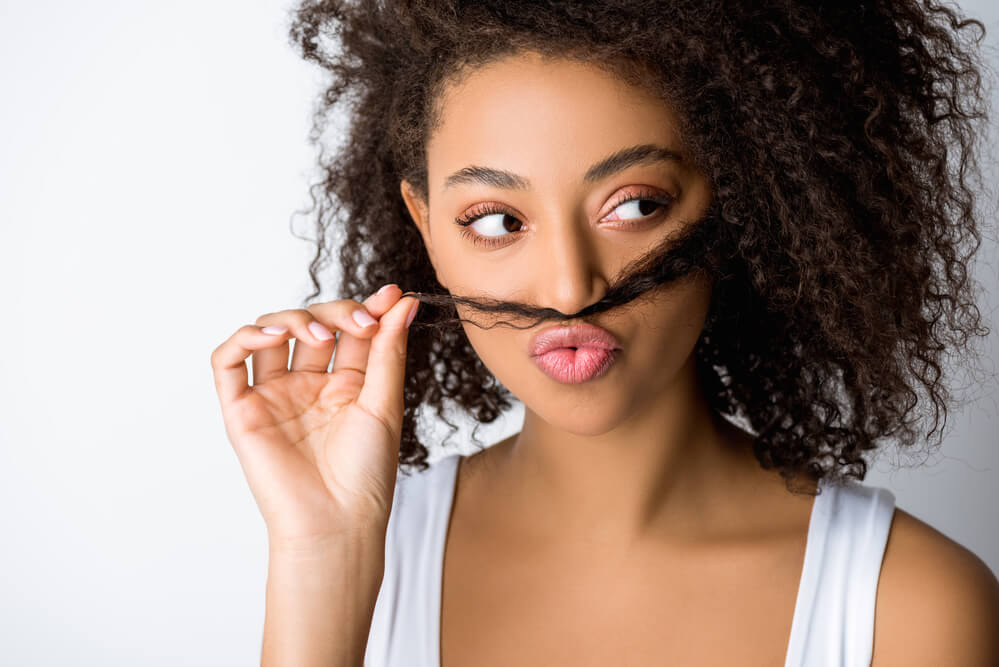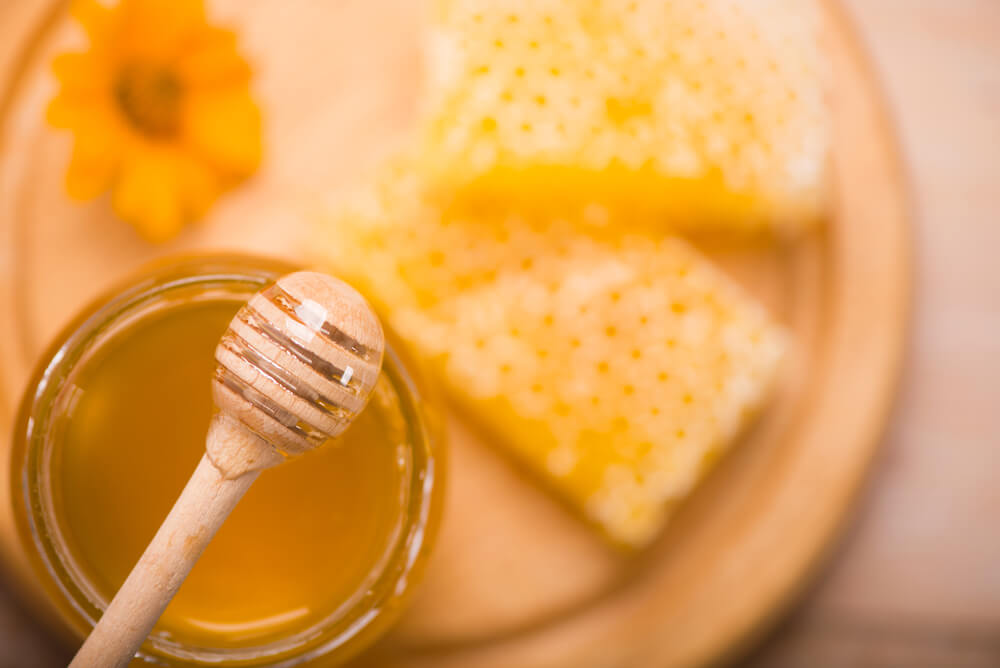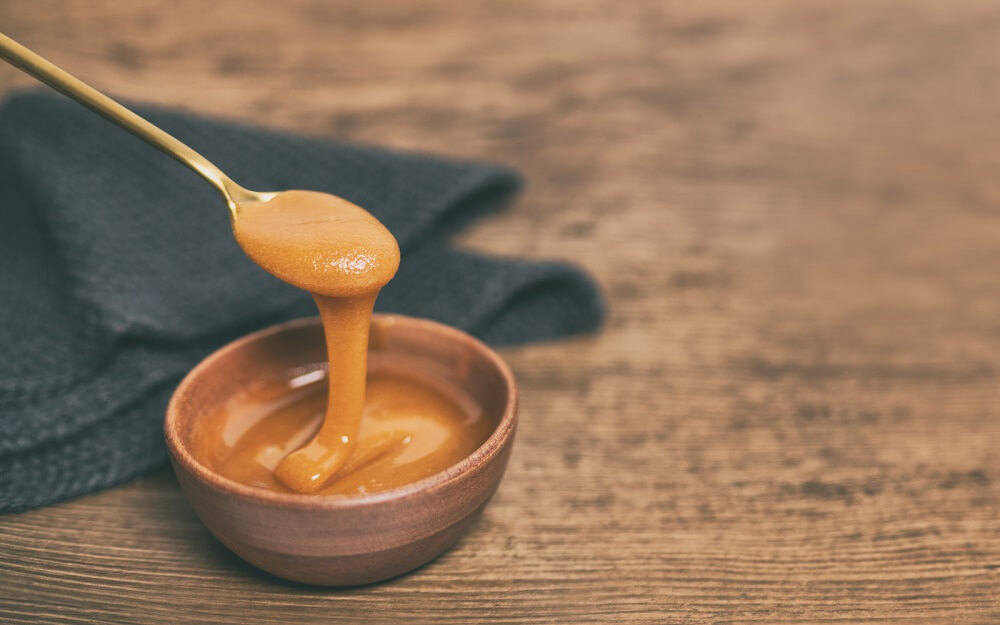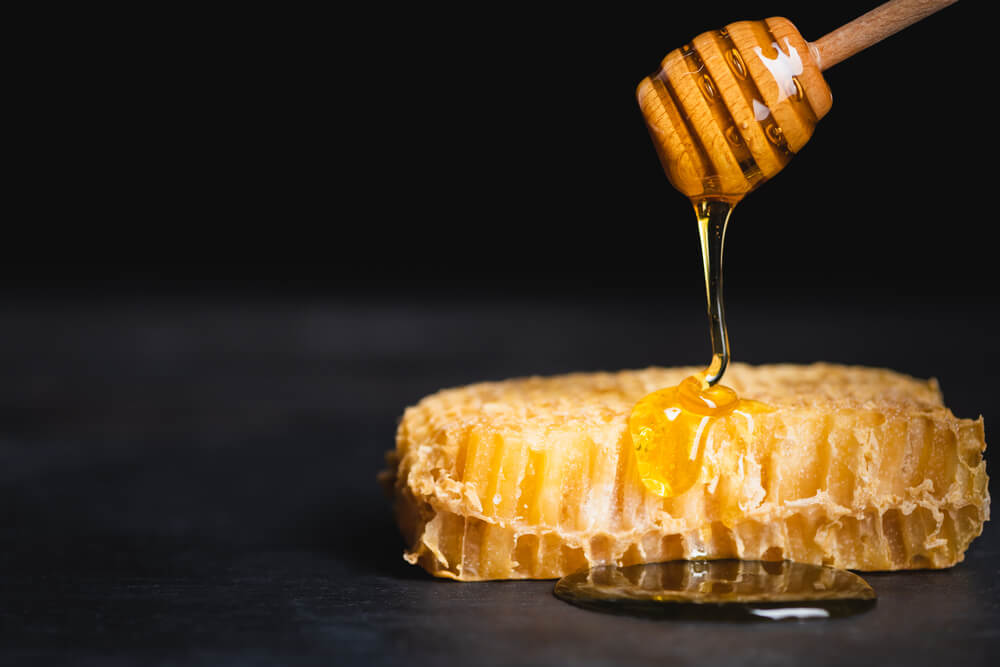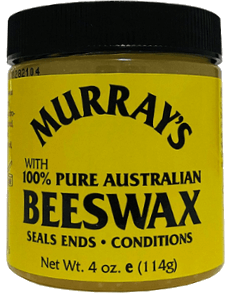Table of Contents:
What are the Benefits of Beeswax on Hair?
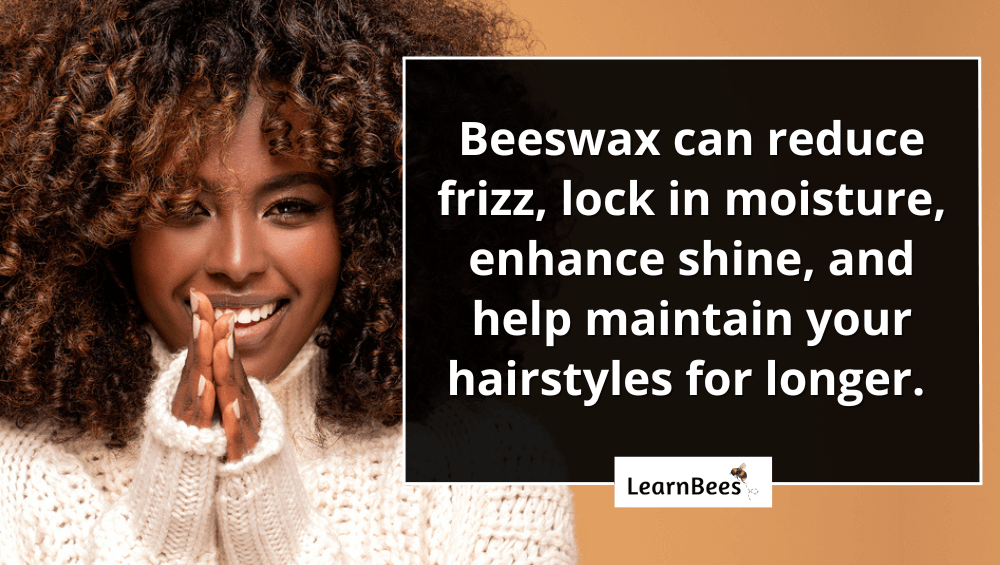
The secret’s out.
Using beeswax on your hair can be a great way to maintain your hairstyles and lock in moisture.
But how does it work?
Let’s start at the beginning.
Beeswax is a natural wax made by honeybees. Honeybees create beeswax to store honey and raise baby bees.(1)
Thanks to its moisturizing properties, beeswax is often used in hair and skincare products. What’s more, beeswax has been shown to soften the skin, reduce water loss, and provide antiseptic properties that promote wound healing.(2, 3)
But that’s not all.
Other benefits of beeswax on hair include:
- Maintain hairstyles: Beeswax reduces frizz and holds your style in place, so it stays neat and lasts longer. This is especially important for hot and humid climates.
- Smooth flyaways: The texture of beeswax makes it helpful for taming individual strands and controlling edges.
- Seal split ends: Although the only way to remove split ends is to cut them off, beeswax can temporarily seal the ends and provide a sleek look.
- Lock in moisture: Beeswax contains traces of vitamin A, which helps to condition the hair. When your hair is hydrated, strands look shinier, curls appear springier, and the overall hair is stronger.(4)
- Helps treat some skin conditions: Beeswax is antibacterial, so it’s often used in creams or ointments to treat things such as psoriasis, atopic dermatitis, and redness.(5)
How to Use Beeswax on Hair
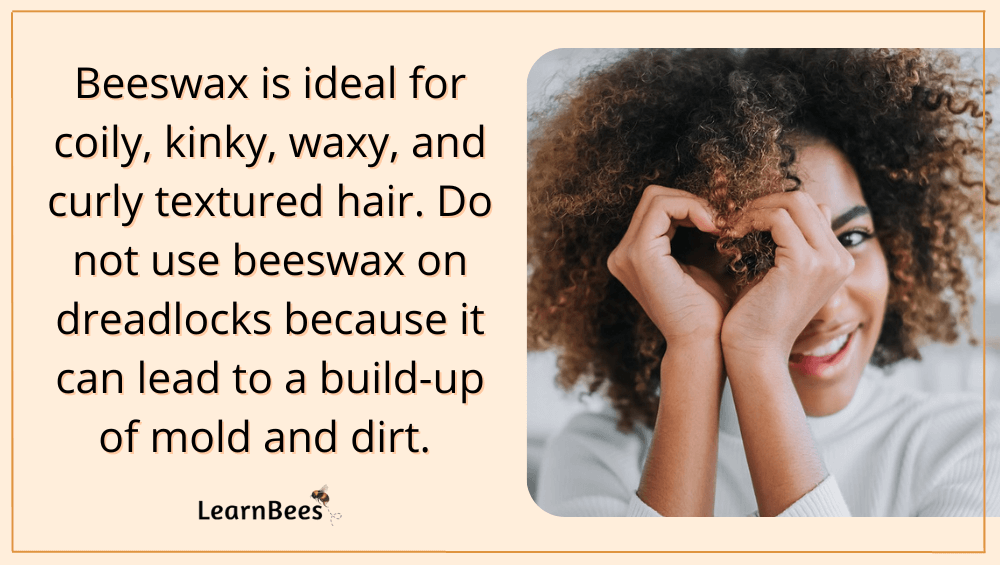
Now the question becomes…
Who should use beeswax for their hair?
Beeswax is ideal for coily, kinky, waxy, and curly textured hair. It’s best used as an edge control or hair slicker for ponytails and waves.
To define curls, beeswax should be mixed with a small amount of oil – such as argan oil – to make it creamier and easier to apply.
But keep in mind:
You only need a small amount of oil and beeswax to do the trick. Applying too much can weigh down your hair, so start with small amounts and work your way up.
With that in mind, many people prefer using beeswax over gel because it doesn’t give you the crunchy, hard feeling that some gels can.
But now here’s the thing:
We don’t recommend using beeswax on dreadlocks. Using beeswax on locs will make it easier for dirt, dust, and lint to stick to your hair. Additionally, beeswax can prevent water from draining out of your locs properly, leaving you with mold issues later on.
Not good.
Keeping your scalp healthy and clean is a big priority when maintaining locs.
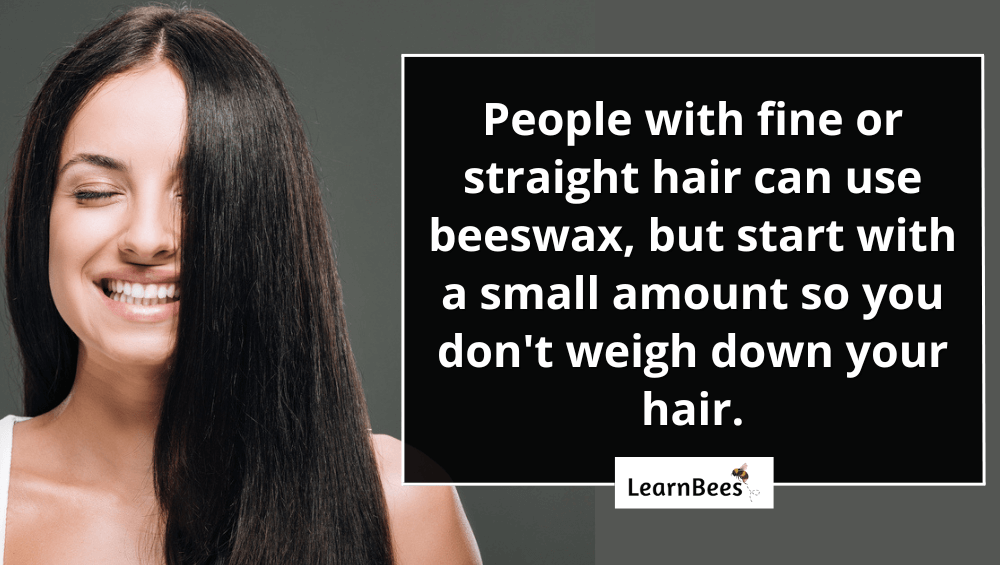
Lastly, people with fine or straight hair can use beeswax, but they should do so in moderation to avoid weighing down the hair. Beeswax is heavy and can make fine hair appear oily.
So, in short, you can:
- Use beeswax for hair edges
- Use beeswax to define curls
- Use beeswax for hair braiding
- Use beeswax for hair twist outs
- Use beeswax to simply lock in moisture and reduce frizz
The easiest way to start using beeswax for your hair is to use a pre-made balm.
You can also make your own beeswax balm at home by buying pure beeswax, melting it over the stove, and mixing in argan oil, shea butter, and cornstarch.
Ingredients for Beeswax Balm:
- 2 tablespoons beeswax pastilles
- 2 tablespoons argan oil
- 3 tablespoons shea butter
- 1 tablespoon cornstarch
Directions for Making Beeswax Balm:
- Melt the beeswax pellets on medium heat over the stove
- Add the argan oil and stir until thoroughly mixed
- Remove from heat and pour in the shea butter and cornstarch.
- Stir thoroughly until everything is combined
- Pour into a small container and allow it to cool
How Do You Remove Beeswax on Hair?
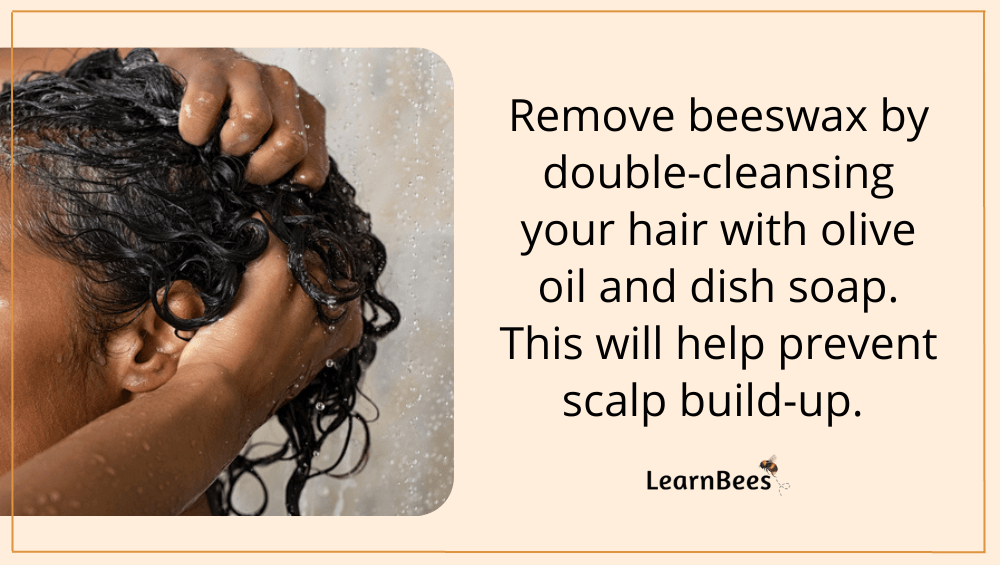
This is the million-dollar question.
Many people are scared to try beeswax because they’re concerned about scalp build-up, clogged pores, and greasy hair.
And for good reason.
Scalp build-up happens when sebum accumulates alongside hair products, sweat, and dead skin cells on the scalp. If left untreated, it can lead to thinning hair because the clogged hair follicles don’t allow new hair to come to the surface.(6)
The good news?
Having a solid cleansing routine can prevent beeswax and other products from building up on your hair.
So here’s how you remove beeswax from your hair:
Start by warming up olive oil and massaging it into your strands and scalp. You can place a cap over your head and allow it to sit for a few minutes. Next, wash your hair with dish soap or clarifying shampoo to remove any remaining beeswax.
And remember:
You should wash your scalp twice with the soap or shampoo to thoroughly remove any residue.
Additionally, some people prefer using apple cider vinegar over shampoo. You can try dish soap or apple cider vinegar to see which works best. Just make sure to really massage your scalp to ensure it’s clean.
Also, don’t skip on the olive oil as the first step. Olive oil breaks down the beeswax so it can be washed away easily.
FAQs for Beeswax on Hair
- Is beeswax good for your hair?
- Does beeswax cause build-up in hair?
- Does beeswax wash out of hair?
- How do you use beeswax in hair products?
- Does beeswax clog pores in hair?
- How long does it take beeswax to lock hair?
- Does beeswax make hair shiny?
- Does beeswax help in hair growth?
- Why is beeswax not curly girl approved?
- Is beeswax good for wavy hair?
- Does beeswax hold braids?
- Can you use beeswax in shampoo?
- Is it safe to use beeswax on hair?
- How do you make hair cream with beeswax?
- Does beeswax cause hair loss?
- Is beeswax good for hair removal?
Is beeswax good for your hair?
Yes, beeswax is good for your hair. It can help lock in moisture, reduce frizz, and add shine. Since beeswax can lock in moisture, some people apply a leave-in conditioner to their hair before applying the wax. This hydrates the hair and can help maintain your hairstyle for longer.
—> Go back to the FAQs for beeswax on hair
More to Explore:
Does beeswax cause build-up in hair?
Yes, beeswax can lead to build-up on your hair if you don’t cleanse properly. However, if you wash correctly with olive oil and dish soap, you’ll reduce the likelihood of experiencing build-up.
—> Go back to the FAQs for beeswax on hair
More to Explore:
- Honey Pasteurization: Does it Ruin Raw Honey?
- Honey for Skin Benefits: Directions, Uses, & Risks
- 8 Scientific Benefits of Raw Honey
Does beeswax wash out of hair?
Yes, the beeswax will wash out of your hair if you follow the right steps. You can’t simply wash out beeswax by using regular shampoo.
The best thing to do is apply warm olive oil to your hair, massage it in, and then wash with dish soap or a clarifying shampoo. You may have to double-cleanse your hair with dish soap to ensure you’re removing any beeswax residue.
—> Go back to the FAQs for beeswax on hair
More to Explore:
How do you use beeswax in hair products?
Beeswax can be used in various hair products, such as hair creams, oils, and leave-in conditioners.
When using beeswax in hair products, apply a small amount and evenly distribute it through your hair. You don’t want to use too much beeswax as it can sometimes make your hair appear greasy. It’s best to start with a small amount and then add more if needed.
—> Go back to the FAQs for beeswax on hair
More to Explore:
Does beeswax clog pores in hair?
Yes, beeswax can clog your hair follicles if you don’t cleanse your scalp. This can lead to thinning hair because the clogged follicles don’t allow new hair to come to the surface.
To prevent this, use olive oil to help break down the beeswax. Warm up the olive oil in the palm of your hands and rub it through your scalp and hair. After massaging it in, leave it on for a few minutes. You can put a hair cap on during this process.
Next, rinse your hair with warm water and use dish soap, clarifying shampoo, or apple cider vinegar to cleanse your scalp. Do a double cleanse on your scalp to remove all the residue.
—> Go back to the FAQs for beeswax on hair
More to Explore:
How long does it take beeswax to lock hair?
Beeswax shouldn’t be used to lock hair because it does more harm than good.
People use beeswax to lock and hold their hair in place. However, once you spread beeswax over your locs, it’s hard to get out with a typical wash routine. The beeswax acts as a magnet for dirt, dust, and lint. It also can prevent the locs from draining water properly, leading to mold build-up.
As a result, many people who have dealt with this will cut off their hair due to intense loc-rot inside their locs. Build-up from using beeswax on dreadlocks is challenging to deal with.
—> Go back to the FAQs for beeswax on hair
More to Explore:
Does beeswax make hair shiny?
Yes, using beeswax regularly can increase the shine of your hair. The best way to achieve this is to use a leave-in conditioner before applying the beeswax, then apply the wax mixed with a small amount of argan oil.
If you have fine or a straight hair texture, ensure you don’t apply too much product all at once. Start small and work your way up, so you don’t leave your hair feeling and looking greasy.
—> Go back to the FAQs for beeswax on hair
More to Explore:
Does beeswax help in hair growth?
People often ask:
Is beeswax good for hair growth? Does beeswax thicken hair?
The truth is that there haven’t been many studies examining whether beeswax helps with hair growth. One study performed in 2016 found that a hair product containing beeswax significantly increased hair length after 30 days.(7)
Participants used the product daily to see these results. However, the hair product did include other ingredients, so it’s hard to conclude if beeswax was the leading cause of hair growth.
—> Go back to the FAQs for beeswax on hair
More to Explore:
- The Top 3 Best Manuka Honey Brands
- Orange Blossom Honey: Uses, Benefits, & Risks
- Sourwood Honey: Uses, Benefits, & Risks
Why is beeswax not curly girl approved?
Waxes aren’t typically approved in the Curl Girl Method because it can lead to build-up that isn’t easily removed through co-washing.
While beeswax can be an excellent product for reducing frizz, locking in moisture, and maintaining styles, it isn’t for everyone. You must ensure you remove the beeswax by massaging olive oil onto your scalp and ends.
From there, thoroughly wash your scalp and hair using dish soap, clarifying shampoo, or apple cider vinegar. Wash your hair twice to ensure you’re removing beeswax build-up.
—> Go back to the FAQs for beeswax on hair
More to Explore:
- Honey for the Face: Can You Apply it to the Skin?
- Beeswax vs. Soy Wax: Which is Better for Candle Making?
- How is Honey Useful?
Is beeswax good for wavy hair?
Yes, beeswax can be good for wavy hair textures. However, we suggest starting with a small amount of beeswax. Applying too much can lead to greasy hair.
—> Go back to the FAQs for beeswax on hair
More to Explore:
Does beeswax hold braids?
Yes, beeswax can hold braids and reduce frizz. It also has the added benefit of increasing shine.
—> Go back to the FAQs for beeswax on hair
More to Explore:
Can you use beeswax in shampoo?
No, we don’t recommend using beeswax in shampoo. Beeswax should be cleansed off the scalp, not left to sit on it. Use beeswax on the strands of your hair, and don’t massage it into your scalp.
When it’s time to wash your hair, start by using olive oil to help break down the beeswax so it can be easily washed out.
—> Go back to the FAQs for beeswax on hair
More to Explore:
Is it safe to use beeswax on hair?
Yes, it is safe to use beeswax on hair as long as you’re regularly cleansing your scalp and hair using olive oil and dish soap.
—> Go back to the FAQs for beeswax on hair
How do you make hair cream with beeswax? How do you make hair oil with beeswax?
Ingredients for Beeswax Balm:
- 2 tablespoons beeswax pastilles
- 2 tablespoons argan oil
- 3 tablespoons shea butter
- 1 tablespoon cornstarch
Directions for Making Beeswax Balm:
- Melt the beeswax pellets on medium heat over the stove
- Add the argan oil and stir until thoroughly mixed
- Remove from heat and pour in the shea butter and cornstarch.
- Stir thoroughly until everything is combined
- Pour into a small container and allow it to cool
—> Go back to the FAQs for beeswax on hair
Does beeswax cause hair loss?
Beeswax may result in hair loss if you don’t cleanse your hair properly to remove build-up. This is because not washing your hair with wax or oil can lead to clogged hair follicles. If the hair follicles remain clogged, they can prevent new hair shafts from growing.
—> Go back to the FAQs for beeswax on hair
Is beeswax good for hair removal?
Yes, beeswax is used in many commercial waxes to remove body hair.
